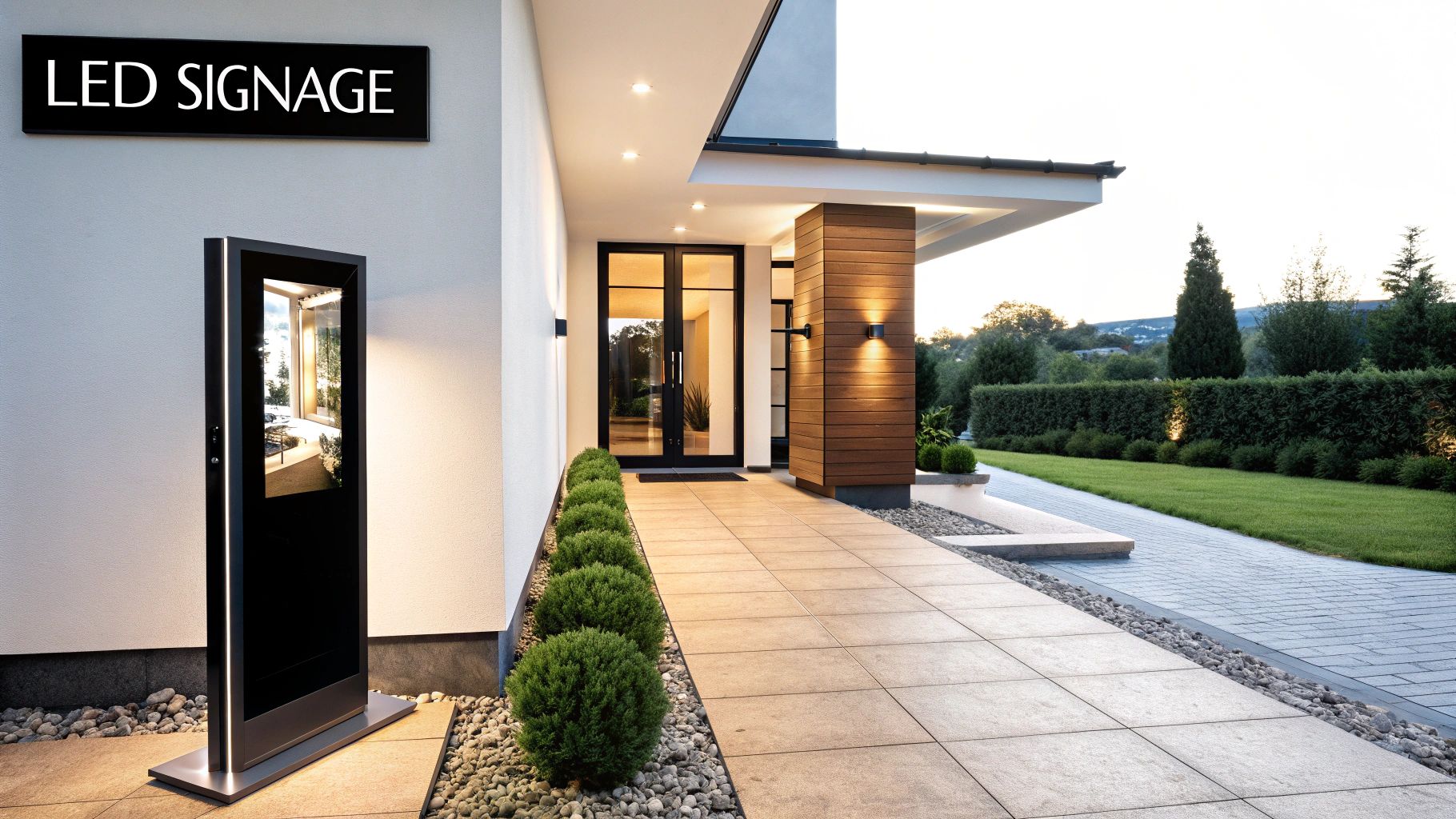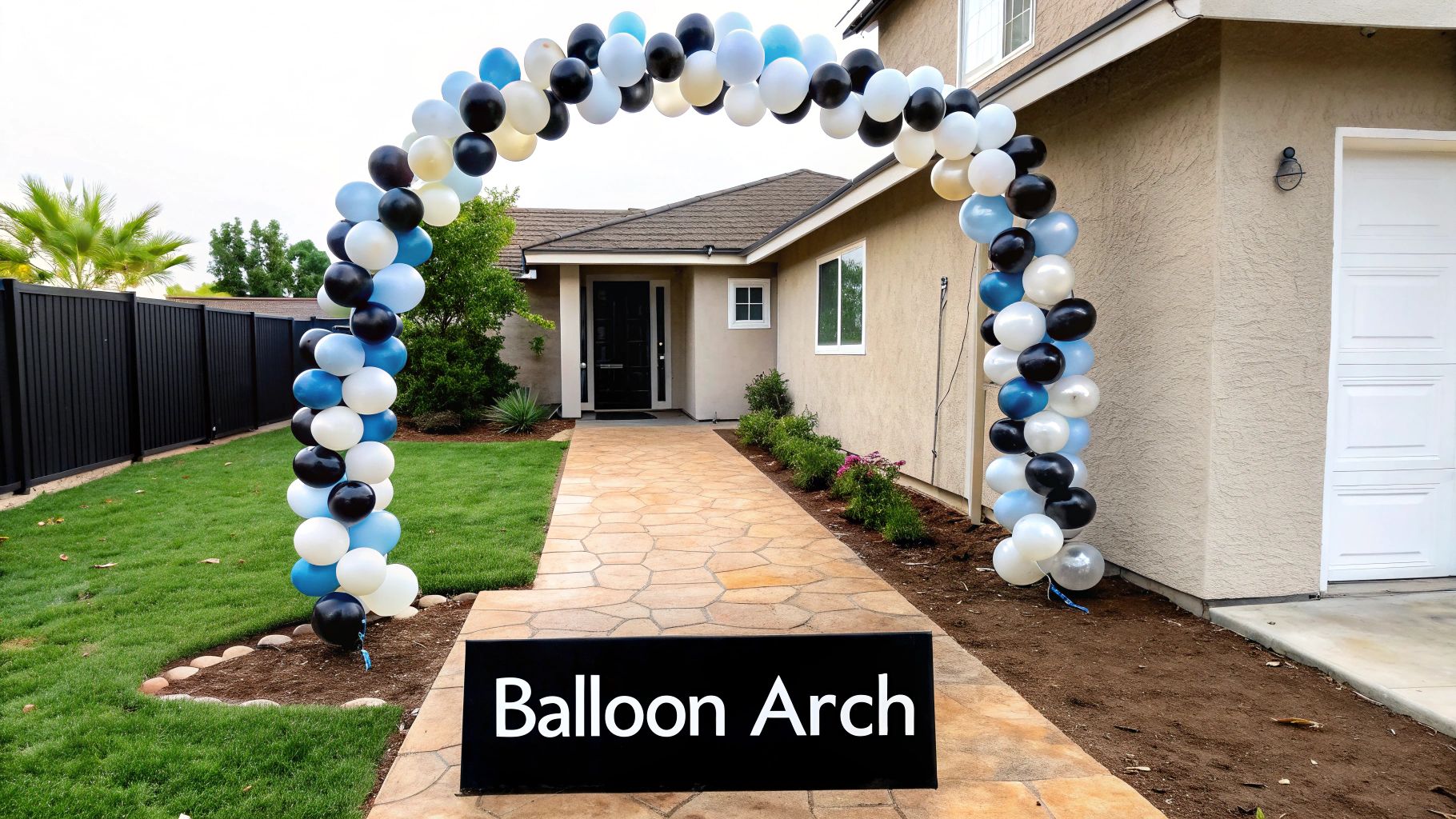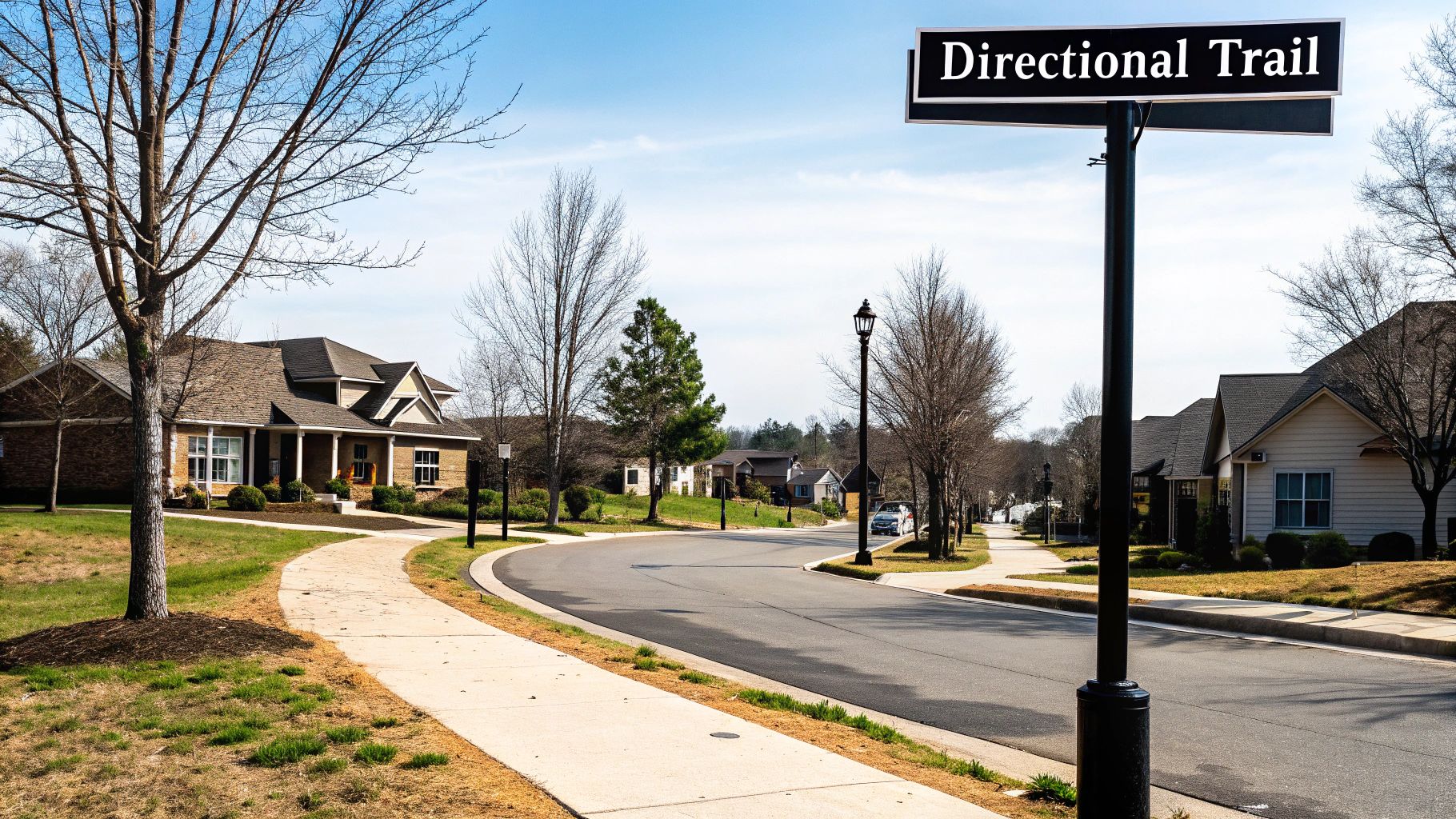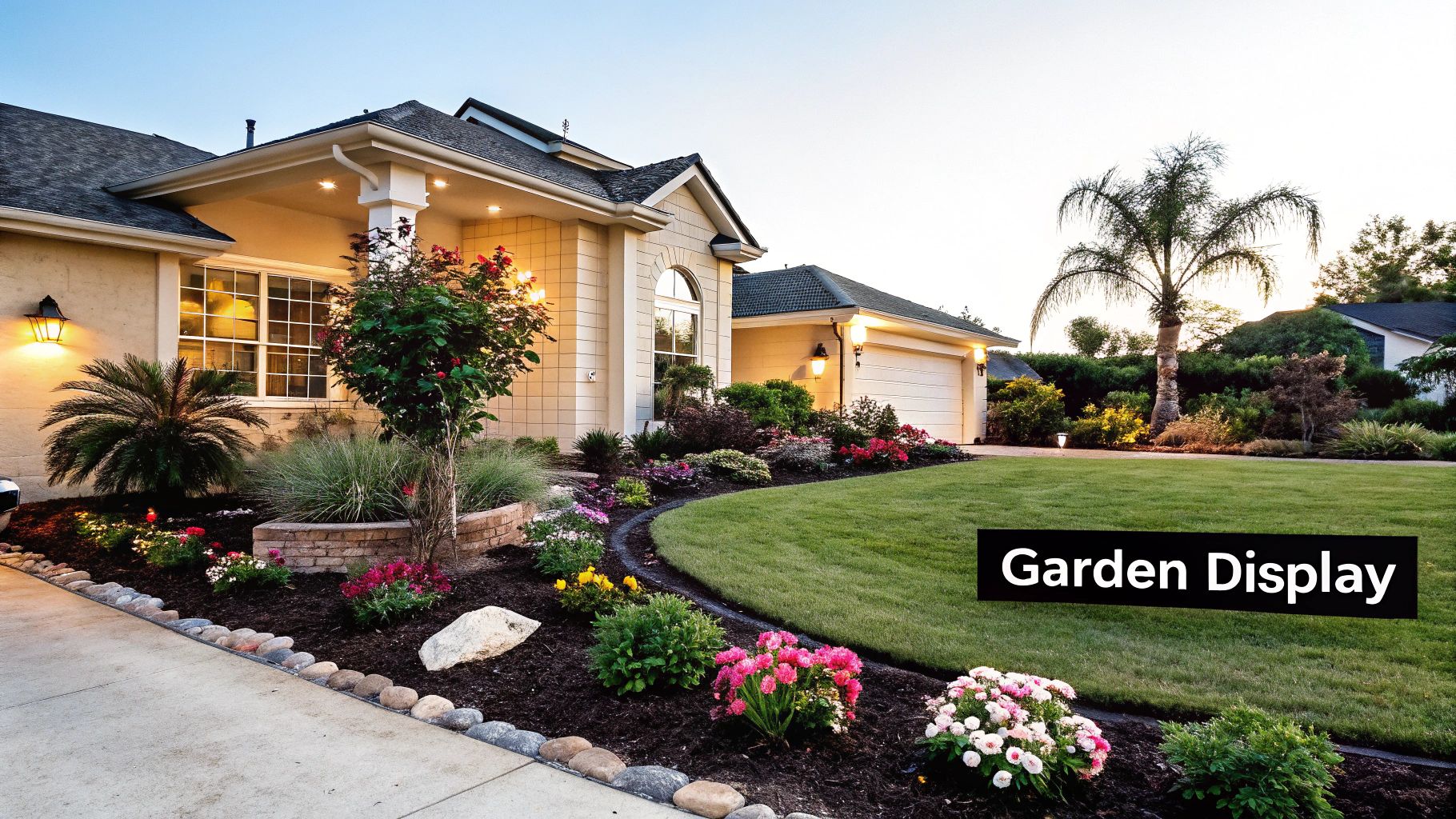7 Creative Open House Sign Ideas for 2025
June 30, 2025
In today's competitive real estate market, a standard 'Open House' A-frame sign can easily fade into the background. To truly capture the attention of potential buyers and create a memorable first impression, agents need to think creatively about their signage. This guide moves beyond the generic and dives into seven innovative open house sign ideas designed to stop traffic, spark curiosity, and drive serious foot traffic to your listings. These concepts are crafted to transform your open house from a passive event into an active marketing opportunity.
We will explore each idea in detail, providing actionable tips, practical examples, and clear insights to help you select the perfect strategy for your next showing. You will learn how to implement:
- High-tech digital displays that stand out day or night.
- Interactive QR code stations that capture leads on the spot.
- Themed sign trails that create an engaging journey to the front door.
From attention-grabbing balloon arches to sophisticated illuminated displays, this list offers fresh perspectives that go far beyond basic directional arrows. Get ready to elevate your approach and make your next open house impossible to ignore.
1. Digital LED Open House Signs
For real estate agents looking to make a high-tech, memorable impression, Digital LED Open House Signs are a game-changer. These are not your standard printed A-frames; they are dynamic electronic displays that use bright LED technology to showcase property details, photos, and even video tours. This modern approach immediately signals a premium, tech-savvy brand, capturing the attention of potential buyers in a way static signs simply cannot.

These signs are particularly effective in competitive, high-traffic urban areas or luxury markets where differentiation is key. For example, brokerages like Compass have been known to leverage sleek, modern tools, and agents in tech-centric locations like Silicon Valley can appeal directly to their target audience by using smart displays. The goal is to stop foot traffic and create an immediate "wow" factor.
How to Implement Digital LED Signs
Successfully using a digital sign requires more than just turning it on. Strategic content and placement are crucial for maximizing its impact.
- Content Rotation: Keep your messages concise and impactful. Rotate content every 5 to 10 seconds to display key features like "4 Beds | 3 Baths," "Newly Renovated Kitchen," the open house times, and high-quality property photos.
- Color and Contrast: Use high-contrast color schemes, such as bright white text on a black background or vibrant colors that pop in daylight. This ensures maximum readability from a distance and for passing cars.
- Power Management: Before every open house, fully charge the sign's battery or ensure you have a reliable power source. A dead sign is worse than no sign at all, so always test its battery life beforehand.
Why This Idea Works
Digital LED displays position you as a modern, forward-thinking agent. They are excellent for attracting attention in visually crowded environments and can convey significantly more information than a traditional sign.
Key Insight: The true power of a digital sign is its ability to be a dynamic information hub. By integrating a QR code, you can bridge the physical and digital worlds. Passersby can scan the code to instantly view the full property listing, take a virtual tour, or even pre-register for the open house. You can explore how QR codes for real estate are transforming property marketing on RecodeQR.com.
2. Balloon Arch and Column Displays
For agents who want to create a festive, can't-miss event, Balloon Arch and Column Displays are a powerful visual tool. These installations go far beyond tying a few balloons to a sign; they are professionally constructed arches or columns that frame a property's entrance, driveway, or key directional sign. This approach transforms a standard open house into a grand celebration, generating excitement and making the property highly visible from a distance.

This idea is particularly effective for new construction developments, luxury properties, or any listing where creating a memorable, high-energy atmosphere is the goal. For instance, Century 21 agents often use their branded black and yellow balloons to create eye-catching arches, reinforcing brand identity. In upscale markets like Scottsdale, agents might use elegant metallic gold and white columns to signal a high-end property, attracting serious buyers and setting a sophisticated tone from the curb.
How to Implement Balloon Displays
Executing a professional-looking balloon display requires careful planning and attention to detail to avoid a deflated, unprofessional appearance.
- Color Coordination: Choose balloon colors that either match your brokerage's branding or complement the home's exterior paint and landscaping. This creates a cohesive and polished look.
- Secure Installation: Wind is the enemy of balloon art. Ensure arches and columns are built on sturdy, weighted bases or secured with sandbags to prevent them from tipping over or blowing away.
- Timing and Durability: Assemble the display as close to the open house start time as possible to ensure balloons look fresh. Use high-quality, professional-grade balloons and consider helium-free, air-filled designs, as they hold their shape longer and are less prone to deflation.
Why This Idea Works
Balloon displays create an undeniable sense of occasion and fun, making potential buyers feel like they are arriving at a special event, not just another property viewing. They are one of the most effective open house sign ideas for drawing attention from down the street and making your listing the focal point of the neighborhood.
Key Insight: The impact of a balloon display is rooted in psychology. It triggers feelings of celebration and excitement, which can create a positive emotional association with the property before a buyer even steps inside. This positive first impression can influence their entire perception of the home.
3. Interactive QR Code Stations
Moving beyond simple directional arrows, Interactive QR Code Stations transform passive signage into an engaging digital gateway for potential buyers. Instead of just announcing an open house, these stations use large, scannable QR codes to provide immediate access to a wealth of information. This approach caters directly to the modern, smartphone-savvy buyer, turning a simple sign into an instant, self-service information hub that bridges the physical and digital worlds.

This idea is incredibly versatile and has been adopted by various segments of the market. Luxury brokerages like Sotheby's International Realty use them to link to high-end virtual tours, while new home builders might use multiple QR codes on a single sign to showcase different floor plans. The core principle is to empower potential buyers with instant, detailed information, reducing friction and capturing qualified leads even before they step inside.
How to Implement Interactive QR Code Stations
A successful QR code station is more than just a code on a sign; it requires thoughtful execution to ensure it's both user-friendly and effective.
- Design for Visibility and Action: Your QR code must be large and prominently displayed, at least 2x2 inches, to be easily scannable from a few feet away. Accompany it with a clear call-to-action like, "Scan for a Virtual Tour" or "See All Property Photos Now!"
- Optimize the Destination: The landing page must be mobile-first. Whether it links to a virtual tour, a mortgage calculator, or the full listing, the experience should be seamless on a smartphone. Slow-loading or desktop-only pages will frustrate users and defeat the purpose.
- Provide a Backup Plan: Not everyone is tech-savvy or has a stable connection. Always include a short, memorable URL (using a URL shortener) or your phone number on the sign as an alternative way to access the information.
Why This Idea Works
Interactive QR Code Stations are one of the most cost-effective and powerful open house sign ideas for lead generation. They provide immense value to buyers by offering instant gratification and position you as an efficient, tech-forward agent.
Key Insight: The true value of a QR code station is its ability to serve as a 24/7 lead capture tool. Drive-by traffic can engage with your listing outside of open house hours. By linking the code to a lead capture form or a virtual tour that requests an email, you can build your contact list effortlessly. Discover more about integrating these powerful tools by exploring how QR codes enhance advertisements on RecodeQR.com.
4. Themed Directional Sign Trails
Instead of using generic, mismatched directional signs, a Themed Directional Sign Trail transforms the journey to the property into an engaging experience. This creative wayfinding system uses a series of coordinated, themed signs to guide potential buyers from main roads right to the front door. This approach builds anticipation and establishes a distinct brand identity for the property before visitors even arrive, making the open house feel like an exclusive event.

This strategy is particularly powerful for properties with a unique character or those located in less obvious areas. For example, a luxury mountain home could use rustic, wood-engraved signs to lead the way, while a beachfront condo might employ a nautical theme with rope and anchor motifs. High-end real estate teams specializing in unique properties often use this method to create a cohesive and memorable marketing narrative from the very first point of contact.
How to Implement a Themed Sign Trail
Creating an effective themed trail requires careful planning and consistent execution. The goal is to make the path clear, enjoyable, and on-brand.
- Theme Selection: Choose a theme that reflects the property's best features. A historic home could have vintage-style signs, while a new development might use sleek, modern designs that mirror its architecture.
- Strategic Placement: Place signs at every key decision point, like major intersections or turns where a driver might get confused. Ensure arrows are large and unambiguous. A good rule is to place a sign where you can see the next one.
- Brand Consistency: Use the same fonts, color palette, and logo across all signs. This reinforces your branding and makes the trail easy for drivers to follow. Don't forget to get any necessary permits for sign placement on public property.
- Prompt Removal: Always remove all signs immediately after the open house concludes. Leaving them up can appear unprofessional and may violate local ordinances.
Why This Idea Works
A themed trail does more than just provide directions; it tells a story and creates an emotional connection. It’s a powerful differentiator in a crowded market and shows a high level of detail and care, which reflects positively on you as an agent and on the property itself.
Key Insight: Elevate your sign trail by adding a QR code to the final sign at the property's entrance. This code can link directly to an immersive virtual tour, allowing visitors to get a sneak peek before they even step inside. For more on this, you can learn how to create virtual tours on RecodeQR.com.
5. Living Plant and Garden Displays
For agents selling properties with strong curb appeal or targeting eco-conscious buyers, Living Plant and Garden Displays offer a uniquely beautiful and organic approach. This idea moves beyond standard signs by integrating open house information with live plants, flowers, and sophisticated landscaping elements. It creates a seamless, natural presentation that enhances the property's aesthetic and signals a connection to nature and sustainable living.
These displays are especially powerful in markets known for beautiful gardens, like the Pacific Northwest, or for properties marketing sustainable features. Imagine a spring open house where directional arrows are flanked by vibrant tulip and daffodil planters, or a luxury estate where the signage is artfully placed within a professionally landscaped showcase. The goal is to make the signage feel like an intentional part of the home's welcoming atmosphere, not just an advertisement.
How to Implement Living Plant Displays
Creating an effective garden display requires a thoughtful approach to horticulture and design. The key is to complement the property, not overwhelm it.
- Seasonal and Climate-Appropriate Choices: Select plants that thrive in the current season and local climate. For a fall open house, use mums and ornamental grasses. For a summer event, opt for drought-tolerant succulents or vibrant petunias. This shows attention to detail and regional awareness.
- Strategic Placement and Portability: Use portable planters, decorative pots, or tasteful window boxes for easy setup and removal. This allows you to create an impactful display at the curb, along a walkway, or near the entrance without permanently altering the landscape.
- Color Coordination: Harmonize the colors of your plants and flowers with the property's exterior paint, trim, and your brand colors. A cohesive color palette creates a polished, high-end look that appeals to design-savvy buyers.
Why This Idea Works
Living Plant and Garden Displays are among the most creative open house sign ideas because they forge an immediate emotional connection. They evoke feelings of home, tranquility, and natural beauty, setting a positive tone before buyers even step inside.
Key Insight: This strategy is about selling a lifestyle, not just a house. By partnering with a local nursery or landscape designer, you can elevate the display into a professional showcase. This not only enhances the open house but also provides a value-add for potential buyers, who might be inspired by the landscaping possibilities. You can even offer a "landscaping credit" or a consultation with the nursery as a closing gift.
6. Vintage and Retro-Styled Signage
For properties with distinct character and historical charm, Vintage and Retro-Styled Signage offers a powerful way to connect with buyers on an emotional level. This approach moves beyond generic signs by using design elements that reflect the home's architectural period. Think Art Deco fonts for a 1920s bungalow or hand-lettered scripts for a Victorian home. This thoughtful detail tells a story before a visitor even steps inside, signaling that the property is unique and has been cared for with an appreciation for its history.
This strategy is particularly effective for real estate agents specializing in historic districts, character homes, or architecturally significant properties. For example, a mid-century modern home’s open house could be advertised with signs using atomic-age typography and a color palette of teal, orange, and mustard yellow. This creates an immersive experience that attracts buyers specifically looking for homes with personality and soul, setting the property apart from modern new-builds.
How to Implement Vintage and Retro-Styled Signage
Creating an authentic vintage look requires careful research and attention to detail. The goal is to be tastefully nostalgic, not kitschy.
- Match the Architectural Era: Research the home's period to inform your design. Use Art Deco's geometric patterns for 1920s homes, ornate typography for Victorian properties, or clean, sans-serif fonts like Futura for mid-century modern listings.
- Choose Authentic Materials: The material of the sign is as important as the design. Consider using carved or painted wood for colonial or craftsman homes. For a retro 1970s vibe, you might even incorporate elements like macrame or unique color plastics.
- Prioritize Readability: While style is key, the sign's primary function is to provide information. Ensure the vintage font is legible from a distance and that essential details like the time and address are clear. Balance aesthetic flair with practical function.
Why This Idea Works
Vintage and retro-styled signage is one of the most effective open house sign ideas for creating an immediate narrative around a property. It showcases a deep appreciation for the home's unique character and appeals directly to buyers who value history and distinctive architecture.
Key Insight: The success of this idea lies in its authenticity. It’s not just about picking a fun font; it's about telling the home's story visually. This approach demonstrates a higher level of marketing sophistication and care, which can build trust with potential buyers and justify a premium price point for a unique property.
7. Illuminated and Light-Up Displays
To make your open house signage truly stand out, especially during twilight hours or on overcast days, Illuminated and Light-Up Displays offer a brilliant solution. This technique involves using professional lighting to make your signs visible, attractive, and dramatic after the sun goes down. By incorporating elements like LED strips, backlighting, or external spotlights, you can extend the effectiveness of your marketing well into the evening, capturing a different segment of potential buyers.
This strategy is particularly powerful for luxury properties, new construction developments, and urban condos where you might host evening open houses or "twilight tours." An elegantly uplit sign in front of a high-end home creates an immediate sense of prestige and exclusivity. Similarly, a backlit display in a downtown condo window ensures your message is seen by evening foot traffic, long after standard A-frames become invisible.
How to Implement Illuminated Displays
Properly lighting a sign is about creating ambiance and readability without causing a distraction. Attention to detail is key to a professional presentation.
- Choose Your Lighting: Use warm white LED lights for a sophisticated and welcoming glow that complements high-end properties. For a modern, sleek look, cool white backlighting can be very effective.
- Placement is Everything: Position spotlights to illuminate the sign face evenly, avoiding "hot spots" or shadows. Ensure the lights are angled to prevent glare for passing drivers or neighbors, which can be both a nuisance and a safety hazard.
- Power and Safety: Always use electrical components, including extension cords and fixtures, that are specifically rated for outdoor use to prevent short circuits or fire risks. For eco-friendly and convenient operation, consider solar-powered spotlights that charge during the day and automatically turn on at dusk.
Why This Idea Works
Illuminated signs extend your marketing hours and create a premium, high-end impression. They signal that you invest in quality presentation, which reflects positively on the property itself. This is one of the most effective open house sign ideas for making an impact after dark.
Key Insight: Use timers to automate your lighting. A timer can switch the lights on at sunset and off late at night, conserving battery or electricity and ensuring your sign is only illuminated during peak viewing hours. This not only saves energy but also respects the neighborhood's peace, demonstrating professionalism and consideration.
Open House Sign Ideas Comparison
| Feature / Item | Implementation Complexity 🔄 | Resource Requirements ⚡ | Expected Outcomes 📊 | Ideal Use Cases 💡 | Key Advantages ⭐ |
|---|---|---|---|---|---|
| Digital LED Open House Signs | Moderate to High: tech setup, power | Requires power source or battery, smartphone app | High visibility, modern look, multi-message | Tech-savvy buyers, luxury and urban markets | Highly visible day/night, reusable |
| Balloon Arch and Column Displays | Moderate: setup and potential pro installation | Balloon materials, weather constraints | Festive atmosphere, eye-catching focal point | Open houses needing celebratory appeal, social media buzz | Affordable high visual impact, photogenic |
| Interactive QR Code Stations | Low to Moderate: QR design and placement | Digital assets, mobile-friendly pages, internet | Instant info access, lead capture | Tech-ready buyers, contactless interaction | Cost-effective, trackable engagement |
| Themed Directional Sign Trails | Moderate to High: multiple sign placement | Multiple signs, permits, high material use | Enhanced navigation, anticipation building | Properties in complex locations, brand reinforcement | Memorable buyer journey, wide visibility |
| Living Plant and Garden Displays | Moderate: seasonal plant care | Plants, professional landscaping, maintenance | Enhanced curb appeal, eco-friendly | Garden-focused and eco-conscious marketing | Natural beauty, memorable aesthetic |
| Vintage and Retro-Styled Signage | High: custom design and materials | Specialty materials, time-intensive craftsmanship | Emotional appeal, distinctive branding | Historic or character properties | Strong nostalgia, unique presentation |
| Illuminated and Light-Up Displays | Moderate to High: lighting setup | LED lighting, power or solar, electrical safety | Extended showing hours, dramatic visibility | Evening showings, luxury and high-visibility needs | Professional look, extended visibility |
Crafting Your Signature Signage Strategy
The journey through innovative open house sign ideas reveals a fundamental truth: signage is no longer just about directions. It is your first handshake with a potential buyer, an extension of your professional brand, and a critical tool for setting the tone of a property showing. Moving beyond the standard red-and-white A-frame isn't just a creative exercise; it's a strategic business decision that can directly impact foot traffic, buyer engagement, and ultimately, the speed and value of a sale.
We have explored a diverse palette of options, from the high-tech allure of Digital LED signs that capture attention from a distance to the charming, experiential quality of a Themed Directional Sign Trail. Each concept serves a distinct purpose. Illuminated displays ensure visibility after dusk, while vintage-styled signs can perfectly complement a property with historic character. The key takeaway is that a one-size-fits-all approach is obsolete. The most effective signage strategy is one that is thoughtfully curated to match the property, the neighborhood, and the target buyer.
Synthesizing Your Strategy: From Ideas to Implementation
To translate these concepts into a cohesive plan, consider the following actionable steps:
- Property Personality Audit: Before choosing a sign, analyze the home’s unique character. Is it modern and minimalist? A historic gem? A family-friendly haven? Let the property's story guide your choice. For instance, a sleek, modern home is the perfect candidate for a digital display or a minimalist light-up sign.
- Define Your Brand Identity: Your signage should be instantly recognizable as yours. Whether you choose a specific color palette, a unique font, or a recurring motif like a living plant display, consistency across all your listings builds brand recall and establishes you as a memorable, detail-oriented agent.
- Integrate, Don't Just Place: The most powerful open house sign ideas are integrated into a larger marketing effort. A QR code station, for example, shouldn't be an afterthought. It should be a central part of your lead capture system, linking buyers to a virtual tour, detailed property specs, or your contact information, bridging the physical and digital experience.
The Lasting Impact of Exceptional Signage
Investing in a superior signage strategy is an investment in your professional reputation. When potential clients see you going the extra mile with a stunning balloon arch or a clever interactive sign, they see an agent who is committed, creative, and willing to do what it takes to stand out. This perception not only helps sell the current listing but also attracts future clients who want that same level of dedication.
Ultimately, your goal is to transform a passive glance into active interest. A memorable sign makes a driver slow down, a pedestrian stop and scan, and a prospective buyer feel genuinely excited to walk through the front door. By moving beyond the basics and crafting a signature approach, you are not just advertising an open house; you are creating an unmissable event.
Ready to elevate your open house signs with interactive technology? RecodeQR makes it simple to generate dynamic QR codes that link buyers directly to virtual tours, property details, and lead capture forms. Visit RecodeQR to create custom codes that will make your signs smarter and your marketing more effective.
Ready to create your QR code?
RecodeQR is the easiest way to create QR codes you can track and edit anytime.
Free 3-day trial. No credit card required.